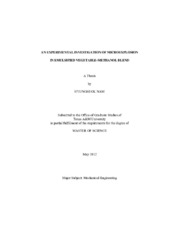| dc.description.abstract | Vegetable oil is one of the most widely available renewable sources of energy that can be used to meet the world’s demands. Many vegetable oils also have the advantage of containing little to no detectable amounts of nitrogen. Recently, research studies have revealed that when two liquids with different vapor pressure values are formed into droplet-like emulsions, a micro-explosion effect can happen under specific environmental conditions. Understanding the micro-explosion phenomena can help increase the efficiency of bio-emulsion combustion as well as reduce pollution levels. Many researchers have conducted experiments to find the optimal condition that induces microexplosion effects. Microexplosion is also associated with the formation of shock waves characteristic of explosions at larger scales. However, little is known about how emulsion composition and droplet size affect the micro-explosion process.
Through this research, methanol-in-vegetable oil emulsion has been studied from the microexplosion point of view using custom made electric furnace equipment with a high speed camera system and an acoustic sensor system. The main goal of this study is to understand the effect of emulsion compositions, chamber temperatures, and droplet sizes on the characteristics of microexplosion. First, an n-hexadecane-in-water emulsion was prepared to validate the performance of the custom-made experimental apparatus using previous published data. Methanol-in-canola oil emulsions with different compositions were also prepared and used to compare the micro-explosion phenomena with water as a volatile compound. Microexplosion events of the blended fuels were captured using a high speed camera and an acoustic sensor. The wave signals generated by the microexplosion were analyzed after converting the signals using a Fast Fourier Transform coded in Matlab.
One of the major findings of this research work was that higher temperatures and higher concentrations of high vapor pressure fluids such as methanol and water in emulsions causes a high probability of microexplosion event due to the sudden expansion of the emulsified fluid. Also, the effect of size on microexplosion was evident in the greater probability of explosion. Methanol-in-canola oil emulsion with 15 % methanol with droplets size of 200 m placed in a furnace chamber heated to 980 ˚C showed optimal microexplosion behavior based on the formation of fine droplets. Also, smaller droplets produced higher frequencies, which could be used to detect microexplosion without high speed imaging. When large droplets microexploded, lower frequencies were detected in all the blends. | en |


